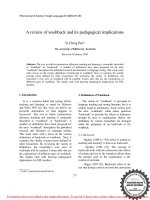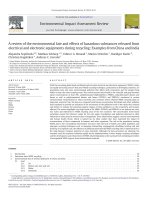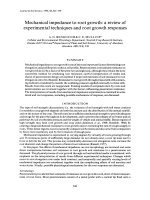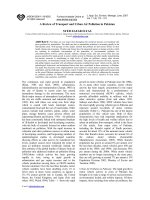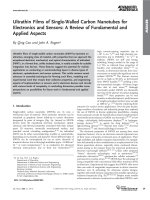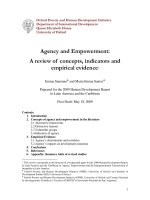A Review of Algebra, by Romeyn Henry Rivenburg pot
Bạn đang xem bản rút gọn của tài liệu. Xem và tải ngay bản đầy đủ của tài liệu tại đây (1.94 MB, 281 trang )
The Project Gutenberg EBook of A Review of
Algebra, by Romeyn Henry Rivenburg
This eBook is for the use of anyone
anywhere at no cost and with
almost no restrictions whatsoever. You may
copy it, give it away or
re-use it under the terms of the Project
Gutenberg License included
with this eBook or online at
www.gutenberg.org
Title: A Review of Algebra
Author: Romeyn Henry Rivenburg
Release Date: January 9, 2012 [EBook
#38536]
Language: English
*** START OF THIS PROJECT GUTENBERG EBOOK
A REVIEW OF ALGEBRA ***
Produced by Peter Vachuska, Alex Buie,
Erica
Pfister-Altschul and the Online
Distributed Proofreading
Team at
A REVIEW OF
ALGEBRA
BY
ROMEYN HENRY
RIVENBURG, A.M.
HEAD OF THE DEPARTMENT OF
MATHEMATICS
THE PEDDIE INSTITUTE,
HIGHTSTOWN, N.J.
AMERICAN BOOK COMPANY
NEW YORK CINCINNATI
CHICAGO
Copyright, 1914,
By ROMEYN H. RIVENBURG.
Copyright, 1914, in Great Britain.
A REVIEW OF ALGEBRA.
E. P. 6
PREFACE
In most high schools the course in
Elementary Algebra is finished by the end
of the second year. By the senior year,
most students have forgotten many of the
principles, and a thorough review is
necessary in order to prepare college
candidates for the entrance examinations
and for effective work in the freshman
year in college. Recognizing this need,
many schools are devoting at least two
periods a week for part of the senior year
to a review of algebra.
For such a review the regular textbook is
inadequate. From an embarrassment of
riches the teacher finds it laborious to
select the proper examples, while the
student wastes time in searching for
scattered assignments. The object of this
book is to conserve the time and effort of
both teacher and student, by providing a
thorough and effective review that can
readily be completed, if need be, in two
periods a week for a half year.
Each student is expected to use his regular
textbook in algebra for reference, as he
would use a dictionary,—to recall a
definition, a rule, or a process that he has
forgotten. He should be encouraged to
think his way out wherever possible,
however, and to refer to the textbook only
when forced to do so as a last resort.
The definitions given in the General
Outline should be reviewed as occasion
arises for their use. The whole Outline can
be profitably employed for rapid class
reviews, by covering the part of the
Outline that indicates the answer, the
method, the example, or the formula, as
the case may be.
The whole scheme of the book is
ordinarily to have a page of problems
represent a day's work. This, of course,
does not apply to the Outlines or the few
pages of theory, which can be covered
more rapidly. By this plan, making only a
part of the omissions indicated in the next
paragraph, the essentials of the algebra
can be readily covered, if need be, in from
thirty to thirty-two lessons, thus leaving
time for tests, even if only eighteen weeks,
of two periods each, are allotted to the
course.
If a brief course is desired, the
Miscellaneous Examples (pp. 31 to 35, 50
to 52), many of the problems at the end of
the book, and the College Entrance
Examinations may be omitted without
marring the continuity or the
comprehensiveness of the review.
ROMEYN H. RIVENBURG.
CONTENTS
PAGES
Outline of Elementary and
Intermediate Algebra 7-13
Order of Operations, Evaluation,
Parentheses 14
Special Rules of Multiplication and
Division 15
Cases in Factoring 16, 17
Factoring 18
Highest Common Factor and
Lowest Common Multiple 19
Fractions 20
Complex Fractions and Fractional
Equations 21, 22
Simultaneous Equations and
Involution 23, 24
Square Root 25
Theory of Exponents 26-28
Radicals 29, 30
Miscellaneous Examples, Algebra
to Quadratics 31-35
Quadratic Equations 36, 37
The Theory of Quadratic Equations
38-41
Outline of Simultaneous Quadratics
42, 43
Simultaneous Quadratics 44
Ratio and Proportion 45, 46
Arithmetical Progression 47
Geometrical Progression 48
The Binomial Theorem 49
Miscellaneous Examples,
Quadratics and Beyond 50-52
Problems—Linear Equations,
Simultaneous Equations,
Quadratic Equations,
Simultaneous Quadratics 53-57
College Entrance Examinations 58-
80
OUTLINE OF
ELEMENTARY AND
INTERMEDIATE
ALGEBRA
Important Definitions
Factors; coefficient; exponent; power;
base; term; algebraic sum; similar terms;
degree; homogeneous expression; linear
equation; root of an equation; root of an
expression; identity; conditional equation;
prime quantity; highest common factor (H.
C. F.); lowest common multiple (L. C.
M.); involution; evolution; imaginary
number; real number; rational; similar
radicals; binomial surd; pure quadratic
equation; affected quadratic equation;
equation in the quadratic form;
simultaneous linear equations;
simultaneous quadratic equations;
discriminant; symmetrical expression;
ratio; proportion; fourth proportional;
third proportional; mean proportional;
arithmetic progression; geometric
progression;
Special Rules for Multiplication and
Division
1. Square of the sum of two quantities.
2. Square of the difference of two
quantities.
3. Product of the sum and difference of
two quantities.
4. Product of two binomials having a
common term.
5. Product of two binomials whose
corresponding terms are similar.
6. Square of a polynomial.
7. Sum of two cubes.
8. Difference of two cubes.
9. Sum or difference of two like powers.
Cases in Factoring
1. Common monomial factor.
2. Trinomial that is a perfect square.
3. The difference of two squares.
(a) Two terms.
(b) Four terms.
(c) Six terms.
(d) Incomplete square.
4. Trinomial of the form
5. Trinomial of the form
6. Sum or difference of
two cubes. See "Special Rules," 7
and 8.
two like powers. See "Special
Rules," 9.
7. Common polynomial factor. Grouping.
8. Factor Theorem.
H. C. F. and L. C. M.
H. C. F.
L. C. M.
Fractions
Reduction to lowest terms.
Reduction of a mixed number to an
improper fraction.
Reduction of an improper fraction to a
mixed number.
Addition and subtraction of fractions.
Multiplication and division of fractions.
Law of signs in division, changing signs of
factors, etc.
Complex fractions.
Simultaneous Equations
Solved by
addition or subtraction.
substitution.
comparison.
Graphical representation.
Involution
Law of signs.
Binomial theorem laws.
Expansion of
monomials and fractions.
binomials.
trinomials.
Evolution
Law of signs.
Evolution of monomials and fractions.
Square root of algebraic expressions.
Square root of arithmetical numbers.
Optional
Cube root of algebraic expressions.
Cube root of arithmetical numbers.
Theory of Exponents
P r o o fs :
Meaning of
fractional exponent.
zero exponent.
negative exponent.
Four rules
To multiply quantities having the
same base, add exponents.
To divide quantities having the same
base, subtract exponents.
To raise to a power, multiply
exponents.
To extract a root, divide the exponent
of the power by the index of the root.
Radicals
Radical in its simplest form.
Transformation of radicals
Fraction under the radical sign.
Reduction to an entire surd.
Changing to surds of different order.
Reduction to simplest form.
Addition and subtraction of radicals.
Multiplication and division of radicals
Rationalization
Monomial denominator.
Binomial denominator.
Trinomial denominator.
Square root of a binomial surd.
Radical equations. Always check results to
avoid extraneous roots.
Quadratic Equations
Pure.
Affected.
Methods of solving

